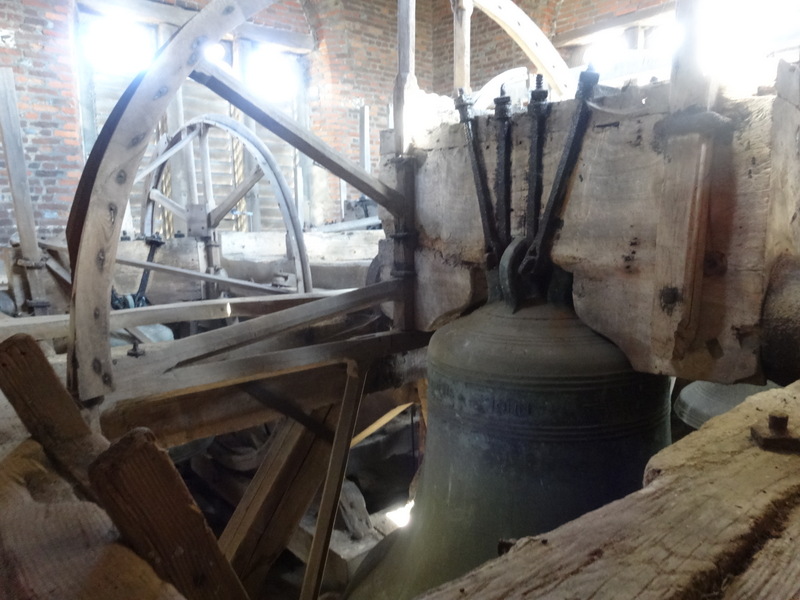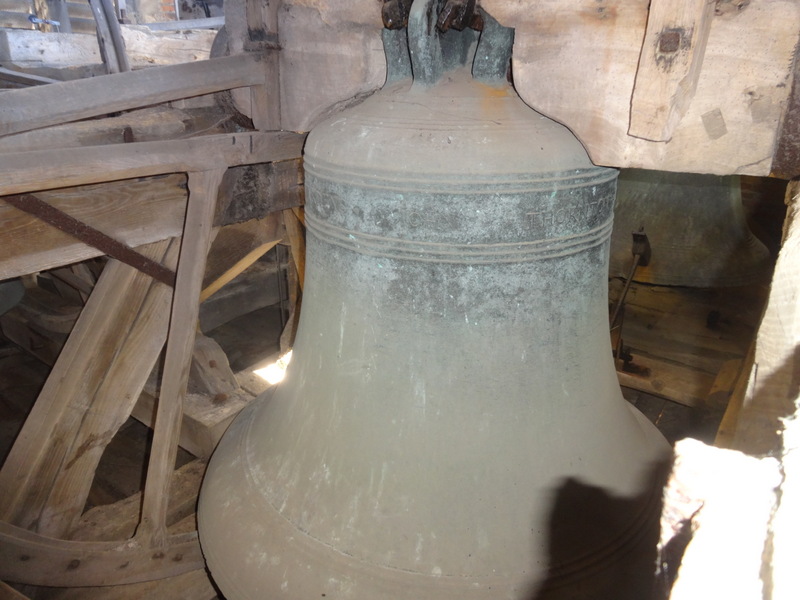Bell ringing
Bell ringing at both Dedham and Ardleigh churches is always needing new volunteers, to ring at the services, and also at weddings and other special occasions. If you are interested in joining either team, please contact the Parishes office on 01206 322 136.
Dedham's Bells
Dedham's bells unfortunately can no longer be rung in the traditional English manner, a system first evolved in the 16th century, where the bells swung almost 360 degrees from mouth uppermost to mouth uppermost every time the bell is sounded, a process that requires considerable skill and control by the bell ringer at the other end of the rope. Developing this skill takes hours of practice in order to have complete control over the bell to be able to make it sound at exactly the correct time in relation to the other bells whilst ringing.
Unfortunately, due to the stresses on the tower by the swinging bells, severe cracks appeared on the walls and together with the considerable movement of the bell frame, caused the bells to become very difficult to control, eventually this deteriorated to such an extent that all full circle ringing ceased by around 1898. Since then, the bells have been chimed hanging stationary, mouth down, firstly with the bell rope attached to the clapper and then later by a set of chiming hammers installed by the Whitechapel Bell Foundry, enabling the bells to be sounded, pulling the rope causing the hammer to strike the bell, a simple means of ringing the bell.
The bells are usually chimed on the second and fourth Sundays of each month by by four people chiming two bells each for 25 minutes prior to the service, followed by a single bell tolled 30 times, indicating that the service is due to start.. The bells are also chimed for weddings and other special occasions.
Dedham bell-ringers are always looking out for new volunteer ringers. Bell-ringing counts as part of the Duke of Edinburgh’s award for community service. Other bonuses include £15 pay per bell-ringer for a wedding and the unexpected fact that bell ringing is a gentle workout: “I began bell-ringing eight years ago after my husband died – weekends were tough when everyone is with their family. We’re a wonderful group – there’s great camaraderie.” The art of bell-ringing, of getting your timing and “sounding” right, she says, is learned partly by ear by listening and imitating and from peals written down. Dedham ringers may no longer attempt the three hour and 16 minutes complete peal of 1818 but they have a repertoire of three “changes” each with their own history:
Dedham church has always been much in demand as a magnificent and glorious setting for weddings when, as Anne Lipscombe (previous bell captain) says, the bells ring out: “The bride and groom may not choose to have the choir but they almost always want the bells. We ring for 20 minutes, starting as the bride comes up the aisle to leave the church and it is the most lovely sound: uplifting and joyous!”
Ardleigh's Bells
At Ardleigh, things are very different, as it needs one ringer for each of the eight bells, and they usually ring on the first and third Sundays of the month, for around half an hour prior to the service. They also hold a regular two hour practice every Tuesday evening to advance their skills and to teach new ringers. The bells are rung for weddings and other special occasions and also for funerals if requested.
At Ardleigh, they practice the art of change ringing where the bells start by ringing down the scale then change to a different order every time they sound without repetition. Often ringing quarter peals consisting of a minimum of 1250 changes of the order of the bells, and for special occasions full peals, a minimum of 5000 changes, which takes around 3 hours to complete. On eight bells, the total number of changes possible without repetition is factorial eight, that's 40,320 changes. This was achieved once on the ninth attempt by a band of ringers in 1963 on the light peal of bells at Loughborough bell foundry, taking them 17 hours and 58 minutes of non-stop ringing and concentration, a tremendous achievement.
History
In the Dedham church inventory of 1552 it states that there were V bells weighing VI score hundred and one and odd. All we know moving forward is that in the present ring of bells,
numbers one to five were all cast in 1754 by Thomas Gardiner of Sudbury Suffolk. This would suggest that there was obviously a major restoration of the bell installation around 1754/5 presumably replacing some of the older bells. However three remain and they are the sixth bell by Robert Burford of London cast probably in the church yard around 1410
(incidentally he also cast the Tenor the largest bell at Ardleigh at around the same time). The seventh bell cast by John Darbie in 1675 and the Tenor by John Thornton of Sudbury in 1717.
Before the full circle ringing was stopped the bells were rung to a total of five full peals, the first on March 17th 1818 and the last on 19th March 1845.
Ardleigh originally had six bells, numbers one and two both cast by John Darbie, the treble in 1676 and the second in 1675. The third bell was cast by Thomas Gardiner of Sudbury in 1727. The fourth bell by Charles Newman in 1689, the fifth bell which was cracked was recast by J Brient of Hertford in 1802 and the tenor is by Richard Burford circa 1410. In 1892 the peal was augmented to eight bells by the addition of two extra bells cast by Mears and Stainbank of the Whitechapel Bell Foundry London and all eight bells were hung in a new oak frame made by Bowel of Ipswich. A major restoration took place in 1955 when all the bells with the exception of the 1667 John Darbie bell and the Robert Burford Tenor were recast by John Taylor's of Loughborough and re hung with all new fittings in the Bowel oak frame of 1892 which is still in excellent condition.The first peal on the eight was rung on the 9th August 1892. Since then
a further one hundred and eleven peals have been rung on these bells up to January 2023.
David Culham.
 |
 |
|
Pictures taken on a Dedham Church Tower Tour in August 2016. |
|
|
|
|